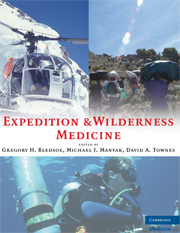Book contents
- Frontmatter
- Contents
- Contributors
- Foreword
- Preface
- Acknowledgments
- PART I EXPEDITION PLANNING
- PART II EXPEDITIONS IN UNIQUE ENVIRONMENTS
- 13 Tactical and Protective Medicine
- 14 Hostile Geopolitical Environments
- 15 Aerospace Medicine
- 16 Polar Medicine
- 17 Tropical Medicine for Expeditions
- 18 Subterranean Medicine
- 19 High-Altitude Medicine
- 20 Medicine at Sea
- 21 Event Medicine
- 22 Telemedicine in Evolution: Implications for Expeditionary Medicine
- 23 Dive Medicine
- PART III ILLNESS AND INJURIES ON EXPEDITIONS
- APPENDIX The Expedition Medical Kit
- Index
18 - Subterranean Medicine
from PART II - EXPEDITIONS IN UNIQUE ENVIRONMENTS
Published online by Cambridge University Press: 05 March 2013
- Frontmatter
- Contents
- Contributors
- Foreword
- Preface
- Acknowledgments
- PART I EXPEDITION PLANNING
- PART II EXPEDITIONS IN UNIQUE ENVIRONMENTS
- 13 Tactical and Protective Medicine
- 14 Hostile Geopolitical Environments
- 15 Aerospace Medicine
- 16 Polar Medicine
- 17 Tropical Medicine for Expeditions
- 18 Subterranean Medicine
- 19 High-Altitude Medicine
- 20 Medicine at Sea
- 21 Event Medicine
- 22 Telemedicine in Evolution: Implications for Expeditionary Medicine
- 23 Dive Medicine
- PART III ILLNESS AND INJURIES ON EXPEDITIONS
- APPENDIX The Expedition Medical Kit
- Index
Summary
INTRODUCTION
Subterranean environments are some of the most diverse and extreme of all wilderness destinations. Subterranean medicine, strictly speaking, is that grouping of medical skills that pertains to medical care of patients below the earth's surface, or in caves. The hazards in caves make them most challenging to deal with from medical and rescue viewpoints, with some obvious and some very unique hazards.
This chapter is an overview of providing medical care in these unique subterranean environments. The goal of this chapter is to introduce the uninitiated medical provider to the unique aspects of subterranean medicine and working in underground environments. Aspects of environmental hazards, cave diving, cave rescue, and the cave medical kit are covered.
SUBTERRANEAN ENVIRONMENTAL HAZARDS
The subterranean environment is unique. Medical providers working underground are not guaranteed basic support that the typical provider takes for granted. When working in a cave or other underground location, a lack of natural lighting, dampness – sometimes even partial submersion – constant exposure to mud and other debris, cold temperatures, and possibly long periods of isolation all factor into the equation.
In addition to handling these general considerations, medics who enter subterranean locations should be aware of more specific threats including the risk of histoplasmosis, exposure to rabies through infected bat populations, hypothermia, falls, and the proper handling of waste.
Histoplasmosis
Histoplasmosis is a disease caused by the spore-forming fungus, Histoplasma capsulatum.
- Type
- Chapter
- Information
- Expedition and Wilderness Medicine , pp. 232 - 239Publisher: Cambridge University PressPrint publication year: 2008



